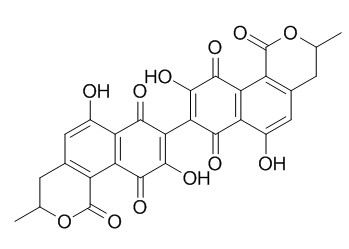Luteosporin
Luteosporin and xanthomegnin are pigments, they are suspected to be genotoxic carcinogens. Luteosporin inhibits porcine pancreatic phospholipase A2 (PLA2) with Ki values of 12.8 microM.
Inquire / Order:
manager@chemfaces.com
Technical Inquiries:
service@chemfaces.com
Tel:
+86-27-84237783
Fax:
+86-27-84254680
Address:
1 Building, No. 83, CheCheng Rd., Wuhan Economic and Technological Development Zone, Wuhan, Hubei 430056, PRC
Providing storage is as stated on the product vial and the vial is kept tightly sealed, the product can be stored for up to
24 months(2-8C).
Wherever possible, you should prepare and use solutions on the same day. However, if you need to make up stock solutions in advance, we recommend that you store the solution as aliquots in tightly sealed vials at -20C. Generally, these will be useable for up to two weeks. Before use, and prior to opening the vial we recommend that you allow your product to equilibrate to room temperature for at least 1 hour.
Need more advice on solubility, usage and handling? Please email to: service@chemfaces.com
The packaging of the product may have turned upside down during transportation, resulting in the natural compounds adhering to the neck or cap of the vial. take the vial out of its packaging and gently shake to let the compounds fall to the bottom of the vial. for liquid products, centrifuge at 200-500 RPM to gather the liquid at the bottom of the vial. try to avoid loss or contamination during handling.
Molecules.2021, 26(23):7390.
Biomed Pharmacother.2024, 181:117647.
Oncotarget.2016, 8(51):88386-88400
Natural Product Communications2023, 18(9).
Environ Toxicol.2024, 39(3):1556-1566.
Pharmacia2024, 71:1-9.
Fitoterapia.2024, 106006.
Integr Med Res.2017, 6(4):395-403
J Agric Food Chem.2017, 65(13):2670-2676
J Nat Prod.2015, 78(6):1339-4
Related and Featured Products
Cancer Res. 1984 Jul;44(7):2918-23.
Genotoxicity of a variety of mycotoxins in the hepatocyte primary culture/DNA repair test using rat and mouse hepatocytes.[Pubmed:
6722817]
METHODS AND RESULTS:
Twenty-eight mycotoxins were studied in the hepatocyte primary culture/DNA repair test using rat and mouse hepatocytes. DNA repair synthesis was elicited by several compounds of unknown carcinogenicity, 5,6- dimethoxysterigmatocystin , versicolorins A and B, averufin , xanthomegnin , Luteosporin , and chrysazin , as well as by the carcinogenic myocotoxins , aflatoxin B1, sterigmatocystin, luteoskyrin , ochratoxin A, azaserine, mitomycin C, and actinomycin D.
CONCLUSIONS:
The positive results with compounds of unknown carcinogenicity suggest that they are possibly genotoxic carcinogens. The carcinogenic mycotoxins, penicillic acid, patulin, griseofulvin, and rugulosin , which did not elicit repair synthesis may be nongenotoxic carcinogens.
J Antibiot (Tokyo). 1985 Jun;38(6):706-12.
Two new inhibitors of phospholipase A2 produced by Penicillium chermesinum. Taxonomy, fermentation, isolation, structure determination and biological properties.[Pubmed:
3839502]
METHODS AND RESULTS:
Plastatin and the known fungal metabolite, Luteosporin, have been isolated from fermentations of Penicillium chermesinum as inhibitors of porcine pancreatic phospholipase A2 (PLA2). Structure 1 for plastatin was deduced from its spectroscopic properties. Plastatin and Luteosporin inhibited pancreatic PLA2 competitively with Ki values of 0.89 microM and 12.8 microM, respectively.
CONCLUSIONS:
PLA2 preparations from Naja naja and Crotalus adamanteus were not significantly inhibited by plastatin and Luteosporin.
Kaempferol 3-O-beta-(6''-p-coumaroyl)glucopyranosyl(1->2)-alpha-L-rhamnopyranoside
Catalog No: CFN95089
CAS No: 111957-48-3
Price: $338/10mg
Methyl caffeate acid
Catalog No: CFN95561
CAS No: 3843-74-1
Price: Inquiry(manager@chemfaces.com)
(3S,5S,E)-1,7-Diphenylhept-1-ene-3,5-diol
Catalog No: CFN95195
CAS No: 87095-75-8
Price: $318/5mg
4,4-di(4-hydroxy-3-methoxyphenly)-2,3-dimethylbutanol
Catalog No: CFN95200
CAS No: 913643-31-9
Price: $368/5mg
Violanone
Catalog No: CFN95385
CAS No: 52250-38-1
Price: $318/10mg
3'-Hydroxy-5,7,4'-trimethoxyflavone
Catalog No: CFN95396
CAS No: 33554-52-8
Price: $318/5mg
threo-Guaiacylglycerol-beta-coniferyl aldehyde ether
Catalog No: CFN95417
CAS No: 650600-33-2
Price: $318/5mg
Jacquilenin
Catalog No: CFN95434
CAS No: 7726-34-3
Price: $318/5mg
5-Hydroxy-4a,8-dimethyl-3-methylen-decahydroazuleno[6,5-b]furan-2(3H)-on
Catalog No: CFN95522
CAS No: 114579-31-6
Price: $318/5mg
Ephedrannin D1
Catalog No: CFN95547
CAS No: 1592431-55-4
Price: $318/5mg



